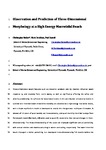Observation and prediction of three-dimensional morphology at a high-energy macrotidal beach

Date
2015-08-15Author
Subject
Metadata
Show full item recordAbstract
Three-dimensional beach features such as crescentic sandbars and rip channels influence beach response to, and recovery from, storm waves, as well as significantly affecting the safety and amenity provided by the surf-zone for beach water-users. In this contribution temporal variations in subtidal and intertidal beach three-dimensionality are observed at a high-energy macrotidal beach, and a simple equilibrium model is developed to predict the changes over multi-year timescales. A dataset of 5.5. years of quasi-weekly bar measurements, and quasi-monthly intertidal surveys from Perranporth beach (Cornwall, UK) were used to quantify seasonal to inter-annual changes in three-dimensionality. The three-dimensionality of the outer bar displayed significant annual periodicity, with annual minima and maxima occurring in winter and spring, respectively. The lower intertidal beach displayed a similar periodicity, but developed three-dimensionality 1-4. months before the outer bar. The model predicts increases or decreases in the scale of three-dimensional features by examining the disparity between instantaneous wave conditions and a temporally varying equilibrium wave condition. A tidally-modulated wave power term determines the rate of morphological change. Negative feedback was found to be an important process governing the changes in three-dimensionality; while free morphological behaviour may drive three-dimensional growth, negative feedback exerts stability in the system, making it inherently predictable using a temporally varying equilibrium value. The model explained 42% and 61% of the overall variability in outer bar and lower beach three-dimensionality, respectively. It skilfully predicted changes outside the training data range, during the most energetic 8-week period of waves measured in the last 65. years off SW England, in winter 2013/14. The model outperformed a simple baseline model (a linear fit), as well as a comparable linearized feedback model from the literature, providing the first long-term (multi-year) predictions of seasonal to inter-annual beach three-dimensionality for a macrotidal beach.
Collections
Publisher
Journal
Volume
Pagination
Recommended, similar items
The following license files are associated with this item:

